The next part of our trip took us on a 30 hour journey to the holiest of cities in India – Varanasi. Due to trains being booked out for weeks, we were forced to take a local bus to Dehradun, during which an Indian woman threw up all over the seat right in front of us! That “1 hour” bus took about 2.5 hours as it idled away in traffic with the ubiquitous cacophony of honks desensitizing us. From Dehradun, a sleeper bus took us to Lucknow, where we finally were able to get a train to Varanasi. It is interesting that without any advanced planning, we arrived to the city right on my 32nd birthday! As drinking is pretty shunned here, after the long journey, we settled for celebrating in a small restaurant overlooking Assi Ghat, on the Ganga while our eyelids drooped with the exhaustion of the day’s travel. Ghats are a series of wide-steps that lead down to the river where pilgrims can bathe, wash their clothes, and offer prayer to the holy river.
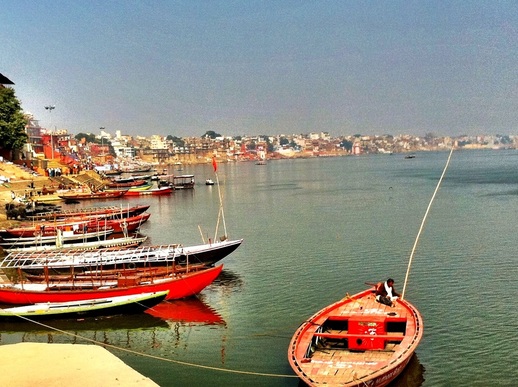
The serene Ganga ghats in Varanasi
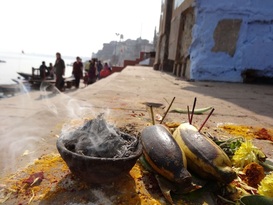
Beautiful offerings along the river
In the end, Varanasi was actually one of our favorite cities in India so far; it is hard to explain, but there really is a certain energy in the city. Firstly, it is one of the world’s oldest continuously inhabited cities in the world (dating back to 1200 B.C.) and is one of the seven holy cities for Hindiusm. As Dadi Aum, owner of Aum Café in Varanasi told us, the city is dedicated to the worship of Shiva, the embodiment of creative destruction, masculinity (represented by many linga statues dotting the riverbank), and the act of renouncing worldly attachments. In this way, it is considered a particularly auspicious place to die because washing in the sacred river prior to death (or just after it) is believed to cleanse one’s attachments to the world, purify one’s karma, and lead to either moksha (liberation from the cycle of birth and death), or at least a more favorable re-birth in the next life.
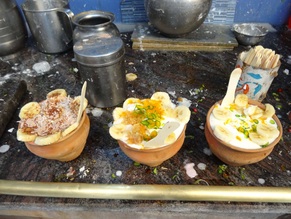
Mmmm...Lassis!
In practice, this makes Varanasi essentially the world’s largest hospice, only minus the palliative care. A steady stream of elderly people travel there to take their last breaths and those whose lives ended prematurely are brought to Varanasi by their families to be washed in the river before being cremated on the steps of certain “burning ghats”. We would sit at the Blue Lassi, an extraordinary place serving up freshly frothed yogurt mixed with pomegranate and shredded apple in little clay cups, and watch a procession of bodies pass us by on their way to the river via the circuitous streets of the old city. They were carried at shoulder height or higher on wooden stretchers, wrapped in shiny orange and silver sheets, the entire stretcher wreathed with orange flowers.
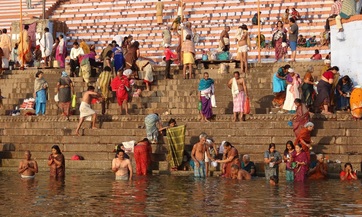
Pilgrims bathing and praying
Exploring this riverside scene the day after my birthday was one of the most profound and dramatic days of my life. We met Eric, a fellow Buddhist hailing from Colorado, who joined us on the walk along the ghats. It was a beautiful morning and the ghats’ peaceful atmosphere was punctuated by the sight of the pilgrims washing themselves and singing out morning prayers. Everything changed, however, when we reached the main burning ghat, where rituals for the dead and cremation are performed in public. The energy of the area immediately changed and overwhelmed us with sadness, curiosity and contemplation.
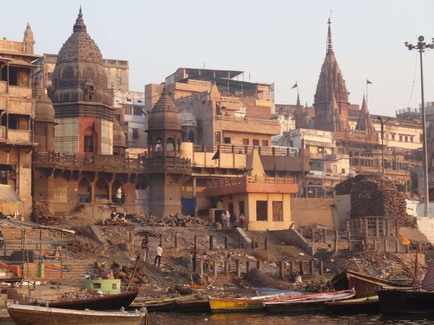
The burning ghat - note the stacked firewood for the cremation ceremonies. There were no rituals happening at the time, which is why we took the picture.
The buildings behind the ghat have a black hue from the constant stream of smoke arising from the square cremation pyres that rest on the river’s edge. Stacked wood rises several stories in the air, ready to be weighed and purchased by pilgrims wishing to cremate a loved one. The pyres sit burning on the river while within lie bodies in various states of incendiary transformation. In juxtaposition to the flame, we sat there frozen as we watched a family wash their son with the Ganga’s waters, removing bandages from bed sores, and then what appeared to be ghee (clarified butter) over his pale body. The two women involved seemed to be very stoic as they were preparing the body. After what felt like a very long time, they finally said their goodbyes and placed his body on a stack of wood and lit it. One of the women, we presume his mother, stumbled as she walked away from her burning son and nearly fainted, her face painted with a picture of utter grief that etched itself in our memories. I felt so many powerful emotions pooling together at that point - compassion for the pain laid out in front of us and an awareness of my own mortality nipping at my heels as I had just celebrated a birthday the day before.
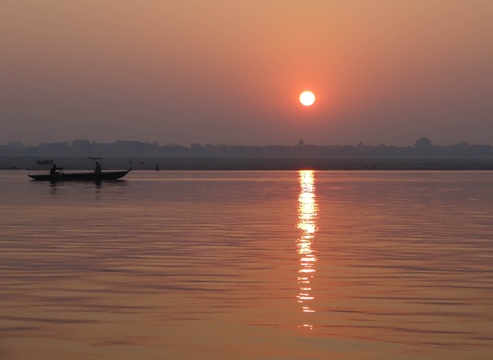
Sunrise on the Ganga
While the body was burning, in the background we watched as people tied bodies to heavy rocks and floated them out to the middle of the river to sink. Apparently some types of death (pregnant women, children, etc…) don’t call for burning, but for this ritual. On the other side of the ghat, body after body streamed down from the streets (from the spot I previously mentioned near Blue Lassi) was washed in the river, and then put on the cremation pyres. The visceral experience of watching the bodies vanish in the fires cannot be put into words, nor could my feelings as I watched the dogs circling around looking for remains to pick on. We couldn’t stay there any longer as the nauseating feeling became too strong, so we continued to explore the streets of the old city, at a loss of words. It seemed that in two days the whole cycle of life was thrusting itself into my awareness – the trauma of birth and the pain of death.
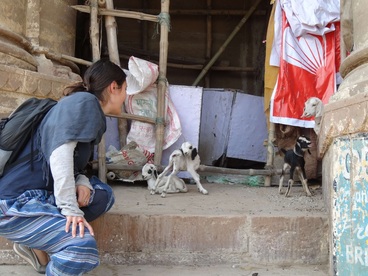
Playing with baby goats along Ganga
But it didn’t just stop with the cremation ghats. Somehow it seemed the whole city was an embodiment of samsara (the cycle of birth and death). As we walked the streets, we saw a dead calf just laying in someone’s yard, while a chicken was picking on it. Dadi Aum told us that it’s not uncommon to see bulls lying dead in garbage heaps. They are not useful for their milk as females are, but the Hindu religion forbids their slaughter for meat. So instead they are just left to die, neglected and alone on the streets. We saw a litter of cute little puppies all huddled up together, some twitching and others still as they died from an unknown disease. But we also saw many mom doggies nursing their litters, baby lambs mewing out to us at every turn, and children playing innocently amidst the garbage littering the ghats (except for the kids who threw a piece of wood at Jeff’s head at night while walking back from the ghats – that wasn’t so innocent).
If there is one thing we value about our spirituality, it is that it has given us a context to deal with these visceral extremes. We know that to close down to the pain we saw around us or to ignore the specter of death only leads to destructive behavior for us and others. But to open to the sobs of the women at the ghats, to move into the pain and the realities of samsara instead of cowering away, brings an equanimity that the Buddha encouraged us all to strive for. The city seems to be whispering “look, here is death laid out in front of you with no intermediary. This will happen to you. You can fear this truth or open to it. The choices you make will ripple through your life.”
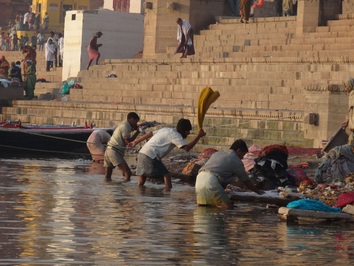
Laundry at the ghats of Ganga
When Dadi Aum heard the call of the city, she sold her house in America and moved to Varanasi, becoming a Shiva devotee. She has rescued a bull she found dying in a trash heap and has tried to bring some dignity to the many who come here to die without the family or friends to help them through the process. For these elderly folks, the journey to Varanasi is meant to be their last one, but with no resources to their name, they just wander the streets, emaciated, weak, and waiting to die. Dadi Aum aspires to open a hospice-shelter to help these poor souls die with dignity – clean, dressed, and ready to open to source. It’s her way of trying to bring compassion to a place steeped in death.
Perhaps it’s the secret of the city. If you can look past the veneer of cow dung littering the streets, men urinating around every corner, and 5 year olds carrying 2 year olds on their begging rounds, you can see the tremendous opportunity Varanasi offers a person who is working on the spiritual path. It offers the opportunity to tap into a current of human experience that is too often ignored by our Western society. It offers the opportunity to see the cycle of birth and death and find some peacefulness there instead of cold fear and rejection. For me, that was a birthday present that no material thing could match. This was indeed the most unusual birthday that will never be forgotten!
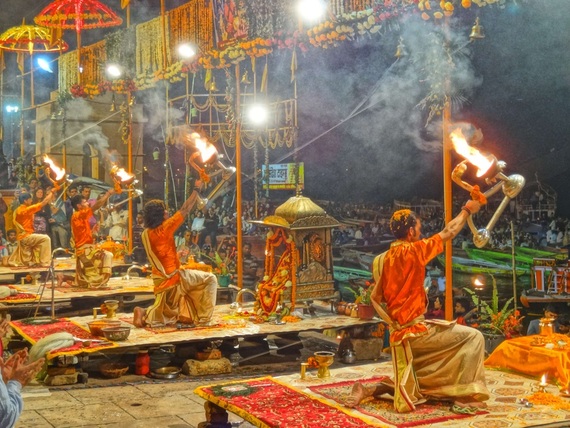
Nightly aarti ceremony on the ganga where ghee soaked wicks are offered to the divine element (represented by the Ganga). The fire is moved in a circular fashon to remind devotees to keep God central in their minds throughout the cycle of the day and year.




